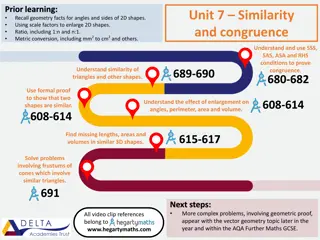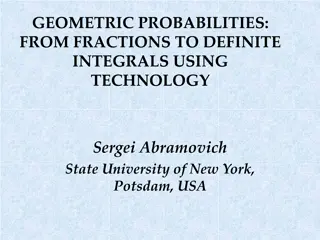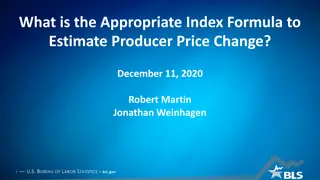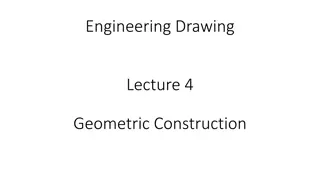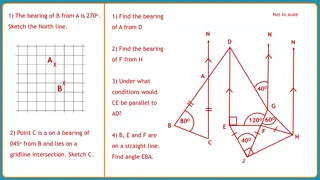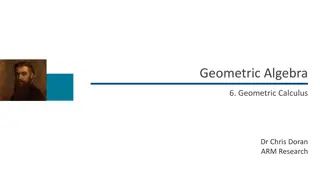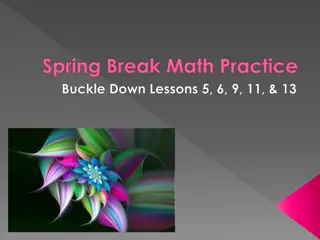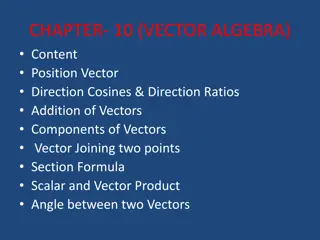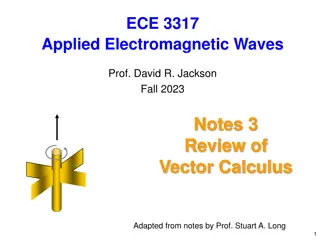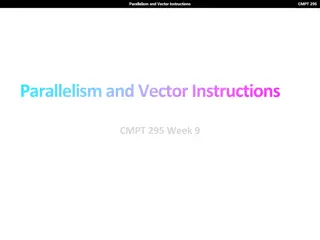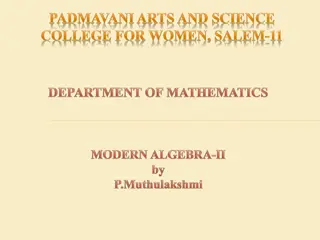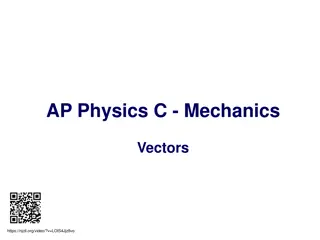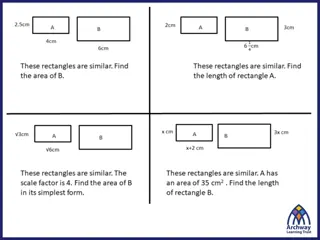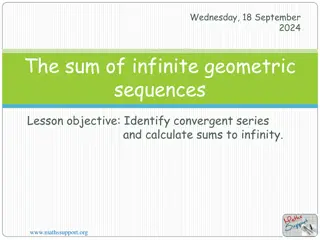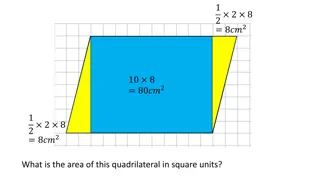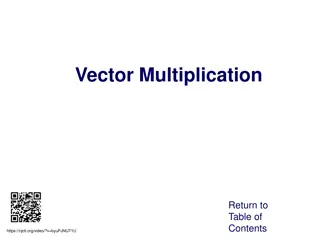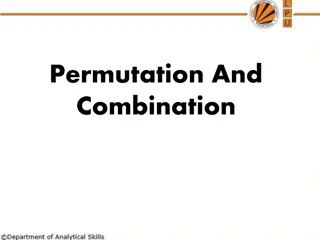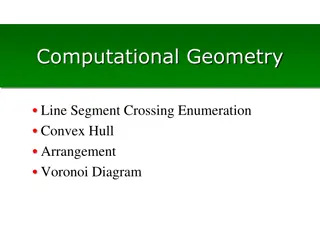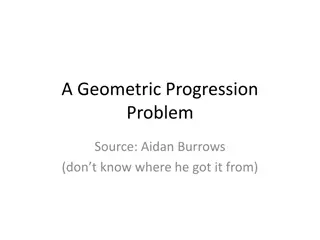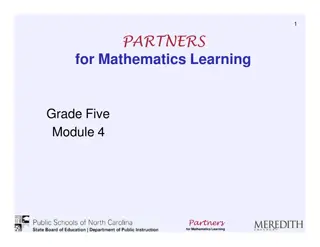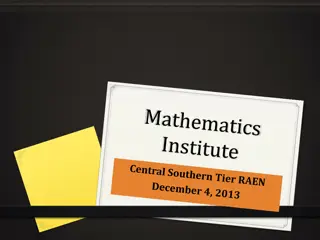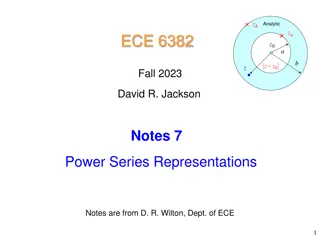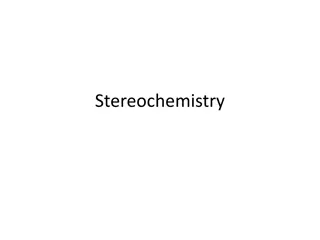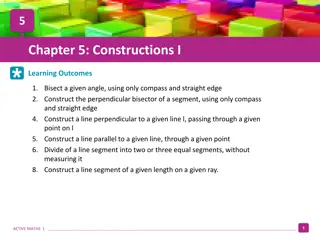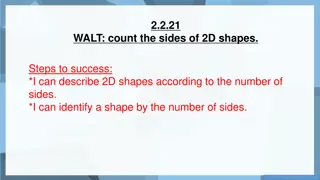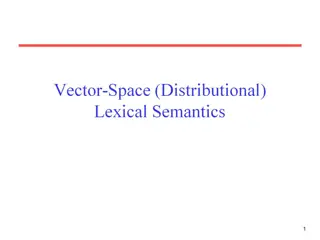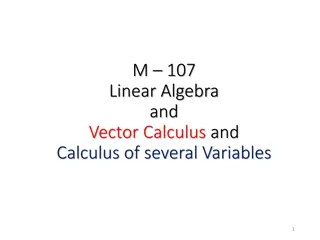Vector Mathematics for Geometric Problem Solving
Learn how to use vectors to solve geometric problems, including finding position vectors of points dividing line segments in given ratios. Explore concepts such as position vectors, ratios, trigonometry, and Pythagoras' theorem to determine angles and side lengths in triangles using vector methods. Discover shortcuts and patterns to speed up problem-solving processes.
Download Presentation

Please find below an Image/Link to download the presentation.
The content on the website is provided AS IS for your information and personal use only. It may not be sold, licensed, or shared on other websites without obtaining consent from the author. Download presentation by click this link. If you encounter any issues during the download, it is possible that the publisher has removed the file from their server.
E N D
Presentation Transcript
Teachings for Exercise 11E
?? = ?? ?? Vectors b - a A 1 You need to be able to use vectors to solve geometric problems and to find the position vector of a point that divides a line segment in a given ratio P 2 B a b O In the diagram the points A and B have position vectors a and b respectively. The point P divides line AB in the ratio 1:2. Find the position vector of P A good start is to write the vector we want in terms of others, and then work each of those out ?? = ?? + ?? Using the ratio, ?? must be 1 3?? ?? = ?? +1 3?? Fill in all the information on the diagram (including vector AB) Replace ?? ?? = ? +1 3? ? Multiply out Also indicate the ratio ?? = ? +1 3? 1 3? Simplify ?? =2 3? +1 3? 11E
?? = ?? ?? Vectors You need to be able to use vectors to solve geometric problems and to find the position vector of a point that divides a line segment in a given ratio A 3? 2? ? B ? 5? In triangle ???, ?? = 3? 2? and ?? = ? 5?. Find the size of ??? in degrees. 2? 3? C Start with a rough sketch We can use ?? and ?? to find ?? There are a number of ways you could approach this, using combinations of Pythagoras theorem and trigonometrical rules ?? = ?? ?? Sub in values ?? = (? 5?) (3? 2?) Calculate ?? = 2? 3? 11E
?? = ?? ?? Vectors You need to be able to use vectors to solve geometric problems and to find the position vector of a point that divides a line segment in a given ratio A c 3? 2? 13 ? B ? 5? 26 b In triangle ???, ?? = 3? 2? and ?? = ? 5?. Find the size of ??? in degrees. 2? 3? 13 a C We can find the magnitude of each side by using Pythagoras Theorem on each vector ?2= ?2+ ?2 2?????? Sub in values ( 13)2= ( 26)2+( 13)2 (2 26 13)???? Calculate parts 13 = 39 (26 2)???? Now we can use the cosine rule to find the angle Rearrange 2 = ???? 2 Inverse Cos ? = 45 11E
?? = ?? ?? Vectors You need to be able to use vectors to solve geometric problems and to find the position vector of a point that divides a line segment in a given ratio A a 13 ? B 90 26 c In triangle ???, ?? = 3? 2? and ?? = ? 5?. Find the size of ??? in degrees. 13 b C Was there a faster way we could have done it? Lets test Pythagoras Theorem ?2+ ?2= ?2 Sub in values 2+ 2= 2 13 13 26 Calculate parts 13 + 13 = 26 Since Pythagoras Theorem works, the triangle must be right-angled, with the longest side being the hypotenuse 11E
?? = ?? ?? Vectors You need to be able to use vectors to solve geometric problems and to find the position vector of a point that divides a line segment in a given ratio A 13 ? 45 B 90 26 In triangle ???, ?? = 3? 2? and ?? = ? 5?. Find the size of ??? in degrees. 13 45 ? C Was there a faster way we could have done it? Also, there are 2 sides the same length, so the triangle is also isosceles! This means that the other 2 angles will be equal! Be on the lookout for patterns in questions that can help you save time! 11E
?? = ?? ?? Vectors ?? = (? + ?) c A B You need to be able to use vectors to solve geometric problems and to find the position vector of a point that divides a line segment in a given ratio a P OABC is a parallelogram. P is the point where OB and AC intersect. O C The vectors a and c represent OA and OC respectively. c Prove that the diagonals bisect each other. One way to get from O to P Start with OB If the diagonals bisect each other, then P must be the midpoint of both AC and OB OP is parallel to OB so is a multiple of (a + c) ?? = ? + ? We don t know how much for now, so can use (lamda) to represent the unknown quantity Try to find a way to represent OP in different ways ?? = (? + ?) (make sure you don t accidentally assume P is the midpoint this is what we need to prove!) 11E
?? = ?? ?? Vectors ?? = (? + ?) ?? = ? + ?(? ?) A c B You need to be able to use vectors to solve geometric problems and to find the position vector of a point that divides a line segment in a given ratio a P -a OABC is a parallelogram. P is the point where OB and AC intersect. O The vectors a and c represent OA and OC respectively. C c Another way to get from O to P Go from O to A, then A to P We will need AC first Prove that the diagonals bisect each other. If the diagonals bisect each other, then P must be the midpoint of both AC and OB AP is parallel to AC so is a multiple of it. Use a different symbol (usually , mew , for this multiple) Now we have another way to get from O to P ?? = ? ? ?? = ?(? ?) Try to find a way to represent OP in different ways ?? = ?? + ?? (make sure you don t accidentally assume P is the midpoint this is what we need to prove!) Sub in vectors ?? = ? + ?(? ?) 11E
?? = ?? ?? Vectors ?? = (? + ?) ?? = ? + ?(? ?) A B You need to be able to use vectors to solve geometric problems and to find the position vector of a point that divides a line segment in a given ratio a P OABC is a parallelogram. P is the point where OB and AC intersect. O The vectors a and c represent OA and OC respectively. C ?? = (? + ?) As these represent the same vector, the expressions must be equal! ?? = ? + ?(? ?) Prove that the diagonals bisect each other. ? + ? = ? + ?(? ?) Multiply out brackets If the diagonals bisect each other, then P must be the midpoint of both AC and OB ? + ? = ? + ?? ?? Factorise the a terms on the right side ? + ? = (1 ?)? + ?? Now compare sides there must be the same number of a s and c s on each = 1 ? = ? Sub 2nd equation into the first Try to find a way to represent OP in different ways (make sure you don t accidentally assume P is the midpoint this is what we need to prove!) = 1 Rearrange and solve So P is halfway along OB and AC and hence the lines bisect each other! = 0.5 They are equal 11E = 0.5



